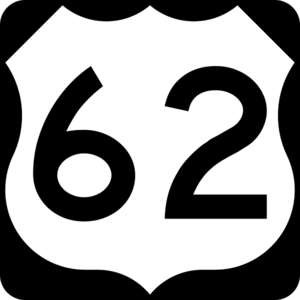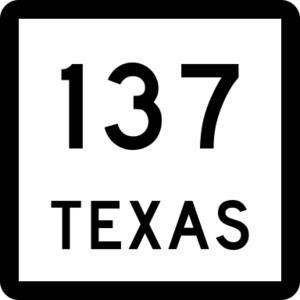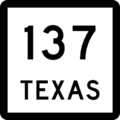Terry County, Texas facts for kids
Quick facts for kids
Terry County
|
|
|---|---|
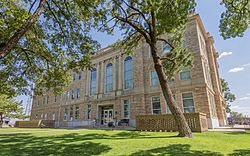
The Terry County Courthouse in Brownfield
|
|
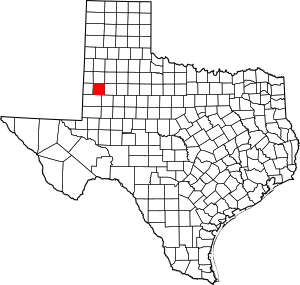
Location within the U.S. state of Texas
|
|
 Texas's location within the U.S. |
|
| Country | |
| State | |
| Founded | 1904 |
| Named for | Benjamin Franklin Terry |
| Seat | Brownfield |
| Largest city | Brownfield |
| Area | |
| • Total | 891 sq mi (2,310 km2) |
| • Land | 889 sq mi (2,300 km2) |
| • Water | 2.1 sq mi (5 km2) 0.2% |
| Population
(2020)
|
|
| • Total | 11,831 |
| • Density | 13.278/sq mi (5.1268/km2) |
| Time zone | UTC−6 (Central) |
| • Summer (DST) | UTC−5 (CDT) |
| Congressional district | 19th |
Terry County is a county located in the U.S. state of Texas. In 2020, about 11,831 people lived there. Its main town, also called its county seat, is Brownfield. The county was first marked out in 1876 and officially started in 1904. It is named after Benjamin Franklin Terry, a colonel from the American Civil War. Terry County is well-known for growing a lot of pumpkins, making it one of the top pumpkin-producing counties in the United States.
Contents
History of Terry County
Terry County was created from Bexar County in 1876. It was named after Colonel Benjamin Franklin Terry. He was famous for leading a group of soldiers called Terry's Texas Rangers during the American Civil War.
In 1877, a group of soldiers known as the Nolan Expedition traveled through the county. They were looking for animals that had been taken by Comanche people. By the time settlers arrived, most Native American tribes had moved away. This was because the large herds of buffalo, which they relied on, had become very small due to hunters.
Terry County officially began its government in 1904. Brownfield was chosen as the county seat, which is the center of the county's government.
Early settlers included ranchers like Ira J. Coulver and Marion V. Brownfield. By 1910, Terry County had 235 farms. Farmers grew crops on about 23,000 acres (93 square kilometers) of land. Corn was the most important crop at that time.
Terry County is located in the Permian Basin, an area rich in oil. Oil was discovered here in 1940, and oil production quickly began. By 1991, nearly 363 million barrels of crude oil had been taken from Terry County's land since 1940. In 1991, Terry County was also one of the leading counties in Texas for growing cotton.
Geography of Terry County
Terry County covers a total area of about 891 square miles (2,308 square kilometers). Most of this area, about 889 square miles (2,302 square kilometers), is land. Only a small part, about 2.1 square miles (5.4 square kilometers), is covered by water.
Main Roads in Terry County
Several important highways pass through Terry County, making it easy to travel to and from the area.
- U.S. Highway 62
- U.S. Highway 82
- U.S. Highway 380
- U.S. Highway 385
- State Highway 137
Counties Near Terry County
Terry County shares its borders with several other counties:
- Hockley County (north)
- Lynn County (east)
- Dawson County (southeast)
- Gaines County (south)
- Yoakum County (west)
- Cochran County (northwest)
- Lubbock County (northeast)
People of Terry County
| Historical population | |||
|---|---|---|---|
| Census | Pop. | %± | |
| 1890 | 21 | — | |
| 1900 | 48 | 128.6% | |
| 1910 | 1,474 | 2,970.8% | |
| 1920 | 2,236 | 51.7% | |
| 1930 | 8,883 | 297.3% | |
| 1940 | 11,160 | 25.6% | |
| 1950 | 13,107 | 17.4% | |
| 1960 | 16,286 | 24.3% | |
| 1970 | 14,118 | −13.3% | |
| 1980 | 14,581 | 3.3% | |
| 1990 | 13,218 | −9.3% | |
| 2000 | 12,761 | −3.5% | |
| 2010 | 12,651 | −0.9% | |
| 2020 | 11,831 | −6.5% | |
| U.S. Decennial Census 1850–2010 2010 2020 |
|||
The table below shows the different groups of people living in Terry County. The US Census counts people who are Hispanic or Latino as an ethnic group, separate from racial categories. This means a person can be of any race and also be Hispanic or Latino.
| Race / Ethnicity (NH = Non-Hispanic) | Pop 2010 | Pop 2020 | % 2010 | % 2020 |
|---|---|---|---|---|
| White alone (NH) | 5,747 | 4,599 | 45.43% | 38.87% |
| Black or African American alone (NH) | 565 | 389 | 4.47% | 3.29% |
| Native American or Alaska Native alone (NH) | 28 | 29 | 0.22% | 0.25% |
| Asian alone (NH) | 23 | 37 | 0.18% | 0.31% |
| Pacific Islander alone (NH) | 0 | 0 | 0.00% | 0.00% |
| Other race alone (NH) | 5 | 24 | 0.04% | 0.20% |
| Mixed race or Multiracial (NH) | 72 | 184 | 0.57% | 1.56% |
| Hispanic or Latino (any race) | 6,211 | 6,569 | 49.09% | 55.52% |
| Total | 12,651 | 11,831 | 100.00% | 100.00% |
In 2000, there were 12,761 people living in Terry County. There were 4,278 households and 3,247 families. The population density was about 14 people per square mile (5 people per square kilometer).
About 35.8% of households had children under 18 living with them. Most households (59.7%) were married couples. About 22.1% of all households were made up of individuals living alone. The average household had 2.76 people.
The median age of people in the county was 35 years old. About 28.4% of the population was under 18. For every 100 females, there were about 108 males.
The median income for a household was $28,090. For families, it was $33,339. The average income per person was $13,860. About 23.3% of the population lived below the poverty line. This included 32.5% of those under 18 and 13.9% of those 65 or older.
Media and News
Terry County has a weekly newspaper that keeps residents informed. People can also listen to radio stations from nearby towns like KPET 690 AM (Lamesa) and various radio and TV stations from Lubbock. Two radio stations, KKUB-AM and KTTU-FM, are licensed to Brownfield but mainly operate from offices in Lubbock.
Communities in Terry County
Terry County has several towns and communities:
Cities in Terry County
- Brownfield (This is the county seat, where the main county government offices are located.)
- Wellman
Town in Terry County
Unincorporated Communities
These are smaller communities that are not officially organized as cities or towns:
Education in Terry County
Students in Terry County attend schools in various school districts. These districts help provide education for children and teens across the county.
- Brownfield Independent School District
- Dawson Independent School District
- Loop Independent School District
- Meadow Independent School District
- O'Donnell Independent School District
- Ropes Independent School District
- Seagraves Independent School District
- Tahoka Independent School District
- Wellman-Union Consolidated Independent School District
For higher education, Terry County is served by South Plains College.
Images for kids
See also
 In Spanish: Condado de Terry para niños
In Spanish: Condado de Terry para niños


